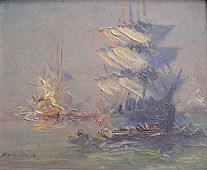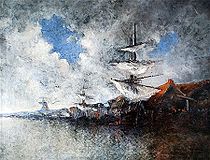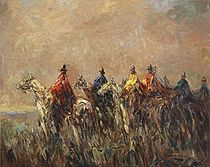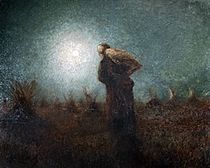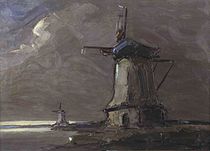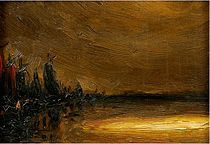Stephen Robert Koekkoek
Stephen Robert Koekkoek (born October 15, 1887 in London , United Kingdom , † December 20, 1934 in Santiago , Chile ) was a Dutch painter who was born in England and worked in South America from 1916 . He was influenced by post-impressionism , but later turned to expressionism . His oeuvre includes around 10,000 paintings.
Life
Stephen Robert came from the Dutch artist family Koekkoek . The artist was the son of the painter Hermanus Koekkoek the Younger , who emigrated from the Netherlands to England in 1869 , the grandson of the painter Hermanus Koekkoek the Elder, and the great-grandson of the painter Johannes Hermanus Koekkoek . In his younger years he often painted with other members of his family in the Netherlands, including his uncle Johannes Hermanus Barend Koekkoek , who influenced him with his loose brushstrokes.
Koekkoek spent a short time in Canada . In 1910 he moved to Lima in Peru and then to Bolivia , where he worked in a tin mine. He continued his trip to Chile, where he made a living from teaching English. A short time later he settled in Mendoza , Argentina , where he married Nella Azzoni , the sister of his painter friend Roberto Azzoni , and had a son. He then lived and worked in Buenos Aires - where he separated from his wife - and in Montevideo .
In 1918, he shared a room with the Colombian poet and journalist Jorge Uribe Escobar in Banfield , Argentina . After his suicide Koekkoek fell into a deep depression. Until then his painting had an impressionistic character, but after the death of his friend his painting style changed with thick brushstrokes in the direction of expressionism.
Koekkoek was described as a strikingly eccentric man with a moody temperament, who was mostly dressed in a British vest and a stetson and carried a cane with a malachite pommel . He smoked large cigars, drank a lot, and used cocaine and morphine regularly. After he was drunk by the police and picked up under the influence of drugs, from 1926 he went to the treatment of psychiatric institutions several times, which treated his symptoms of megalomania . Here he continued to work as a painter; some of the doctors practicing there bought his work.
In 1933 he moved to Rosario , then on to Santiago de Chile. He began to write a play that remained unfinished. In 1934, Koekkoek died of cardiac arrest at the age of 47 after an overdose of alcohol and barbiturates in a hotel room in Santiago. It remained unclear whether it was an accident or suicide. The then President of Chile, his friend Arturo Alessandri , hosted his funeral. In 2004, on the occasion of the seventieth anniversary of his death, a retrospective of his work was shown in the city hall of Córdoba .
Works (selection)
Koekkoek's works met South American tastes and were very popular in Chile and Argentina. He sold successfully at his exhibitions, especially in Buenos Aires, including to the young Juan Perón . The Argentine government acquired one of his paintings and gave it to the Prince of Wales as a gift. Koekkoek was extremely productive as a painter, sometimes painting two or three pictures a day during his manic phases. He often paid his rent with paintings. Koekkoek's works are still popular on the South American art market today; since 1990 around 6,000 of his works have been traded for a total value of more than $ 20 million. In total, he created around 10,000 images.
literature
- Ignacio Gutiérrez Zaldívar: Stephen Robert Koekkoek, 1887-1934. Zurbarán Ediciones, Buenos Aires 2007. ISBN 9789875960275
Web links
- Stephen Robert Koekkoek. In: RKD-Nederlands Instituut voor Kunstgeschiedenis
- Arnoldo Gualino: Stephen Robert Koekkoek. Pintor Inglés en Argentina. January 22, 2015
- Gerrit van Hezel: Het schildersgeslacht Koekkoek en de Zuiderzee (1800-1956). In: Schokland Museum, March 11, 2014
Individual evidence
- ^ Ignacio Gutiérrez Zaldívar: Koekkoek, el más demandado del mercado de arte local. In: Occident, after 2007
- ^ Arnoldo Gualino: Stephen Robert Koekkoek. Pintor Inglés en Argentina. January 22, 2015
| personal data | |
|---|---|
| SURNAME | Koekkoek, Stephen Robert |
| BRIEF DESCRIPTION | Dutch painter |
| DATE OF BIRTH | October 15, 1887 |
| PLACE OF BIRTH | London , UK |
| DATE OF DEATH | December 20, 1934 |
| Place of death | Santiago , Chile |

